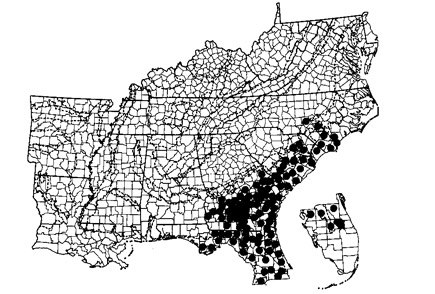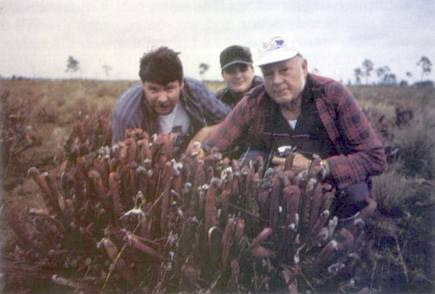 Figure 1. Distribution of S. minor. Shaded county is Okeechobee. Distribution based on Herman (no date), McDaniel (1966), Sheridan #657 Tattnall Co., Ga. FTG and #652 Appling Co., Ga. FTG and Bridges & Orzell #'s 17539 Appling Co.,Ga, 17557 Atkinson Go., Gal, 17359 Colquitt Co., Ga., 17734 Tattnall Co., Ga. and 18371 Turner Co., Ga. at FTG. Physical Map of S E used with permission of W.H. Duncan
Figure 1. Distribution of S. minor. Shaded county is Okeechobee. Distribution based on Herman (no date), McDaniel (1966), Sheridan #657 Tattnall Co., Ga. FTG and #652 Appling Co., Ga. FTG and Bridges & Orzell #'s 17539 Appling Co.,Ga, 17557 Atkinson Go., Gal, 17359 Colquitt Co., Ga., 17734 Tattnall Co., Ga. and 18371 Turner Co., Ga. at FTG. Physical Map of S E used with permission of W.H. Duncan
Print Page | Close Page |
Home
Carnivorous Plant Newsletter 25: 39-41
The Hooded Pitcher Plant, Sarracenia minor Walt., at its Southern Limit
Phil Sheridan
Dept. of Biology
Virginia Commonwealth University,
Richmond, VA 23832
Abstract
A new station for Sarracenia minor Walt. is reported at the species southern limit in Okeechobee County, Florida, and a comprehensive distribution map of the taxon is presented. Approximately one thousand plants occur at this site which is classified as a wet flatwoods ecotone bordering a depression marsh. The short term effects of pasturing whereby woody vegetation is removed and suppressed are contrasted with the long term effects of soil compaction, fertilization, introduction of weedy plant species and alteration of original bog plant community.
Introduction
On January 7, 1995, Clyde Bramblett, Manny Herrera and I were taken by Bruce Bednar to a site he had recently discovered in Okeechobee County, Florida for S. minor. This location represents the southern most point for this species and the genus Sarracenia. I was in Miami giving a talk at Fairchild Tropical Gardens on my Sarracenia genetics work as well as donating my entire herbarium collection to the gardens, and took advantage of the chance to see other horticulturists and natural areas while in the area.
 Figure 1. Distribution of S. minor. Shaded county is Okeechobee. Distribution based on Herman (no date), McDaniel (1966), Sheridan #657 Tattnall Co., Ga. FTG and #652 Appling Co., Ga. FTG and Bridges & Orzell #'s 17539 Appling Co.,Ga, 17557 Atkinson Go., Gal, 17359 Colquitt Co., Ga., 17734 Tattnall Co., Ga. and 18371 Turner Co., Ga. at FTG. Physical Map of S E used with permission of W.H. Duncan
Figure 1. Distribution of S. minor. Shaded county is Okeechobee. Distribution based on Herman (no date), McDaniel (1966), Sheridan #657 Tattnall Co., Ga. FTG and #652 Appling Co., Ga. FTG and Bridges & Orzell #'s 17539 Appling Co.,Ga, 17557 Atkinson Go., Gal, 17359 Colquitt Co., Ga., 17734 Tattnall Co., Ga. and 18371 Turner Co., Ga. at FTG. Physical Map of S E used with permission of W.H. Duncan
Discussion
Sarracenia minor ranges from North Carolina to the southern part of Florida (Fig. 1). The S. minor site we visited occurs in Okeechobee County a few miles from Lake Okeechobee at the southern limit of the species. It is a pastured former wet flatwoods seepage ecotone which grades to a thicket of Serenoa repens (Bartram) Small and Pinus elliotii Engelm. above a depression marsh dominated by Pontederia cordata L. Approximately 1000 pitcher plant clumps were observed with a few individuals in flower. Typical associate seepage species included Drosera capillaris Poiret, Eriocaulon decangulare L., Pinguicula sp. and Lycopodium alopecuroides L.
There are several factors which together or independently may explain why S. minor does not reach further down the Florida peninsula. In the vicinity of Lake Okeechobee, wet acid flatwoods can be found which are typical S. minor habitat. South of this region is a shallow basin with heavily silted marl soils (Schnell, 1980) which would be inhospitable to S. minor due to their alkaline pH. Wet acid pinelands, however, can be found on the eastern and western regions of this basin which could support S. minor. This suggests that soil conditions are not the only limiting factor in the species southern range. Schnell (pers. comm. 1995) reports that growers in the Miami area experience rotting of the rhizomes due to lack of dormancy. Thus unsuitable soils and non-dormancy caused by warm weather may be major factors prohibiting the spread of the genus Sarracenia further south.
Pasturing is generally believed to be beneficial to pitcher plant bogs (Schnell, 1994). Herbivores seem to avoid eating the pitchered leaves, possibly because of color, scent, unpalatability or other factors. Paralyzing alkaloids, such as coniine, which was isolated from S. flava by Mody et al. (1976), may also occur in S. minor and deter browsers from consuming the plants.
The Okeechobee County S. minor site would initially seem to support the hypothesis of a positive association between pasturing and pitcher plants based on the vigor of the clumps. Without fire maintaining open conditions in pitcher plant bogs, pasturing may allow Sarracenia to persist for some time. However in the long run cattle or practices associated with their care may ultimately destroy the plant community of which pitcher plants area part. I have seen the results of this in Virginia with a pastured S. flava site discovered by M.L. Fernald in 1937 called Gary's Church Bog. This pitcher plant site originally covered several acres and has now been reduced to a couple of plants from pasturing. In addition, many of the associate bog rarities have also been eliminated. I also see the same sequence of events occurring in several Florida pitcher plant bogs. Initially, cattle open the shrub bog community in which pitcher plants may occur and we see vigorous growth of Sarracenia. The landowner then starts removing trees and shrubs which may also be temporarily beneficial. At this point many people see what appears to be a healthy pitcher plant bog but in fact the seeds of destruction have already been sown. The cattle begin to compact and rut the soil changing seepage conditions. Seedlings are crushed underfoot. The cattle then complete some of their insidious work by defecating in the bog, which spreads weedy species in their cow pies and enriches the soil.
 Figure 2. Americas most wanted plant hunters. Pulled over by the police as murder suspects. Left to right are Bruce Bednar, Manny Herrara and Clyde Bramblett kneeling behind natural S. minor at its southern limit in Okeechobee County, Florida. Herbarium specimens deposited at FTG, Sheridan 1838.
Figure 2. Americas most wanted plant hunters. Pulled over by the police as murder suspects. Left to right are Bruce Bednar, Manny Herrara and Clyde Bramblett kneeling behind natural S. minor at its southern limit in Okeechobee County, Florida. Herbarium specimens deposited at FTG, Sheridan 1838.
The final coup de grace is usually completed by the landowner who installs drain tile in the bog or limes the soil to "improve" the pasture. I have actually seen a pastured bog where the landowner told me he spread lime along a transect. The Sarracenia were completely absent from this limed lane where I had seen them a couple of years before but still grew in the rest of the pasture off the limed area. Bill Scholl and I still saw the negative effects of pasturing in soil compaction and drainage of wetland by cattle ruts. These two factors may have caused reduction and elimination of pitcher clumps in the unlimed area where there had once been dense stands.
It is important to keep in mind that the effects of pasturing may be a long term phenomenon dependent on herbivore density and associated management practices. It is possible that in some cases it may be the only option for a given area, but in general I would not recommend it if prescribed burning were available. The damage done to the Gary's Church Bog in Virginia occurred over almost a sixty-year period. The photograph of the North Carolina S. rubra ssp. jonesii site cited by Schnell (1994) looks robust even after the prohibition of cattle. Bill Scholl and I visited this same site in the late 1980's and although large clones could still be found, succession was well under way. I did notice a significant amount of smartweed (Polygonum sps.) and woody species shading the pitchers. I consider Polygonum to be a weedy, competitive species introduced or accentuated by the disturbance caused by pasturing. In the absence of any other management initiative, low grade pasturing may be the lesser of evils for this particular site. I was once with the famous botanist Edwin Bridges in a steep hillside seepage bog of S. alata in a National Forest in western Louisiana. As we hiked the site, which had burned over the winter, we found that the forest service had permitted cows to graze the bog. Pasturing in this steep slope bog was resulting in ruts and enrichment from the cows' droppings. Edwin's comment in disgust was "This is completely unacceptable!"
As a final note I should mention an interesting experience we had while exploring this S. minor site in south Florida. When we were leaving this bog, a car slowed down and stopped to observe what was going on. We drove down the road and explored another area but were forced to make a running exit due to an approaching lightning storm. At this time several murderers had made a daring escape from a local correctional facility and we were promptly pulled over by the local police as possible suspects (Fig.2). Somebody had reported us as the escapees running out of the woods. Fortunately, an error had been made and the day ended on a happy note.
Acknowledgements
Thanks to Don Schnell, Bruce Bednar, Clyde Bramblett and Manny Herrera for their review and comment. Appreciation is also extended to Media Production Services of Virginia Commonwealth University for preparing slide of S. minor distribution.
References
Fernald, M.L.1937. Plants of the Inner Coastal Plain of Virginia.Rhodora 39: 386-387.
Herman, S. The Ecology of Pitcher Plant Habitats of the Southeastern United States: A Community Profile. Draft from Tall Timbers Research Station.
McDaniel, S.T.1966. A Taxonomic Revision of Sarracenia (Sarraceniaceae). Unpubl. PhD. Diss., Fla. S. Univ.
Mody, N.V., Henson,R., Hedin, P.A. Kokpol, U. and D.H. Miles. 1976. Isolation of the Insect Paralyzing Agent Coniine from Sarracenia flava. Experimentia 32: 829-830.
Schnell, D. 1980. Notes on Utricularia simulans Pilger (Lentibulariaceae) in Southern Florida. Castanea 45: 270-276.
Schnell, D.1994. Cattle As Sarracenia Stewards? Carnivorous Plant Newsletter 23: 49 - 52.